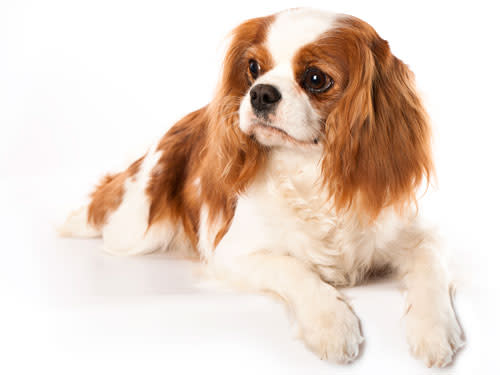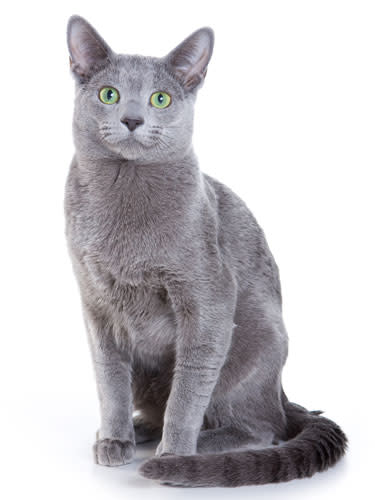How Popular Pet Breeds Got Their Names
By Alexandra Gekas
History of Dogs and Cats
Whether you're a dog person or a cat person, the perfect pet for your home depends a lot on what the animal is bred to do. For instance, if you want a pup to cuddle up with, a Bichon Frise, a lap dog that originated as a companion to French royal families, may be your speed. But if you prefer a running mate, an athletic German Shepherd may be a better bet. And the same goes for cats. To help you choose the new addition to your family, we looked into the origins of well-loved feline and canine breeds. Read on to learn about their backgrounds and find a furry friend that fits your lifestyle. Photo credit: Thinkstock

Dog: Cavalier King Charles Spaniel
If you're looking for an even-tempered buddy, this toy spaniel might be the perfect pick. Named after Britain's King Charles II, who was such a fan of the breed that he never went anywhere without his pack, the Cavalier was bred predominantly as a companion dog, but was also used occasionally as a small game hunter, according to theAmerican Kennel Club(AKC). "Cavaliers have both the toy dog's affection and the inquisitive nose of a hunting dog," says certified personal dog trainer andVetStreet.comexpert Mikkel Becker. "Their laid-back personality makes them a good fit for families with children."Photo credit: iStock
Indulge in 7 quick mood boosters.

Dog: English Bulldog
Originally bred in Britain for bull baiting, a blood sport where dogs pin a bull to the ground by the nose, bulldogs were meant to be ferocious fighters who are resilient to pain. But according to the AKC, breeders tried to eliminate the pooches' fiercer qualities once dog fighting was banned in the 1800s. "Although their ancestors were athletic, today's bulldogs are intolerant of heat and heavy exercise," says Becker. "They're great companions for laid-back families or couples. They don't bark often, which suits them for apartment living." Photo credit: Thinkstock

Dog: German Shepherd
The German Shepherd originated in 1899 in Karlsruhe, Germany, and was a mix of old farm and herding dogs, according to the AKC. Because of his intelligence and loyalty, German Shepherds often work with police, the military and the disabled. But these athletes aren't a good fit for couch potatoes. "They need plenty of mental stimulation and exercise," says Becker. "They also need proper socialization as puppies, since they have the potential to react harshly to strangers and other dogs." Photo credit: Thinkstock
Maximize your workout in 4 easy steps.

Dog: Weimaraner
Originally called the Weimer Pointer, the Weimaraner was bred in the Weimar Republic of Germany to hunt big game. These dogs still chase after moving objects, though they're more likely to be joggers, bikes and cars than bear, boar and deer, says Becker. They're incredibly energetic and smart, earning them the nickname the "dog with the human brain." And over 50% of that mind is devoted to their sniffing abilities, according to Animal Planet. All this means they need to be kept busy-both physically and mentally. "They fit best with active people who have the time to train and exercise," says Becker. "And they need secure yards." Photo credit: Thinkstock

Dog: Bichon Frise
Bichon Frise means small, curly-haired lap dog in French. One of the oldest dog breeds around, they date back to the 14 th century when a water spaniel and a poodle were crossed in the Mediterranean region, according to Animal Planet. By the 16 th century, they became the dog of choice for French royals, and some were performers in traveling circuses, according to the AKC. And they're still loyal companions and lively entertainers. Their non-shedding coat makes the Bichon more tolerable for people with dog allergies, but grooming costs add up: They need haircuts every six to eight weeks. Despite their high-maintenance needs, "these gentle dogs make excellent family companions. They learn tricks fast and are friendly with all people and dogs," says Becker.Photo credit: iStock
Remove household allergens for good.

Cat: Norwegian Forest Cat
Hailing all the way back to the Vikings, these large kitties were called skogkatt in Norse, which translates to forest cat. They're believed to have come out of the Scandinavian woods sometime in the last 4,000 years. Their original role: to prevent rodents from getting into grain, according to Cat Fanciers' Association. "These felines can fit into families with children, dogs and cats, especially if they're around them from kittenhood," says Becker.Photo credit: Thinkstock

Cat: Russian Blue
More grey than blue, this intelligent, independent cat has existed for centuries. "They originated in Russia, just south of the Arctic Circle, and caught mice on ships," says Becker. "They also served as companions to Russian royals and other wealthy people." While they make good pets, they're best-suited for calm, predictable environments, according to Animal Planet. "They enjoy affection, but would likely be overwhelmed in a home with too much commotion or people constantly coming and going," says Becker. Photo credit: Thinkstock
Chill out with 8 stress-fighting foods.

Cat: American Shorthair
One of the most common breeds in the United States, the American Shorthair might be the world's best mouse-catcher, according to Animal Planet. That's probably why the Pilgrims brought over their ancestors. Traced back to the 10 th century, they've morphed from European Shorthair to British Shorthair to Domestic Shorthair before taking on their current incarnation. "These cats are less talkative than Oriental breeds, but if they're socialized at a young age, they adapt to living with anyone, from a family to a single elderly owner," says Becker. But they need plenty of play, affection and mental stimulation, she adds. Photo credit: iStock

Cat: Egyptian Mau
If these cats look familiar, it could be because you've seen their form in ancient Egyptian hieroglyphics. In fact, mau means cat in Egyptian. They were even mummified because their owners cherished them so much. Considered the fastest pedigree cat, they can run over 30 miles per hour. No wonder: They're built like cheetahs (and spotted like them too) and believed to have descended from the wild African cat, according to Animal Planet. "You'll need to keep them busy with lots of play and food puzzles and socialize them early because they're likely to be shy," says Becker. "They also do best in quiet homes. They're sensitive to noise and new situations." Photo credit: Thinkstock
Become fluent in body language.
Original article appeared on WomansDay.com.
You Might Also Like:
10 Ways to Reinvent Your Look
Swimsuits That Flatter Every Shape
15 Clever Uses for Household Items
10 Foolproof Ways to Get in the Mood
10 Things Men Wish Women Knew About Sex
Become a fan of Woman's Day on Facebook and Twitter.
